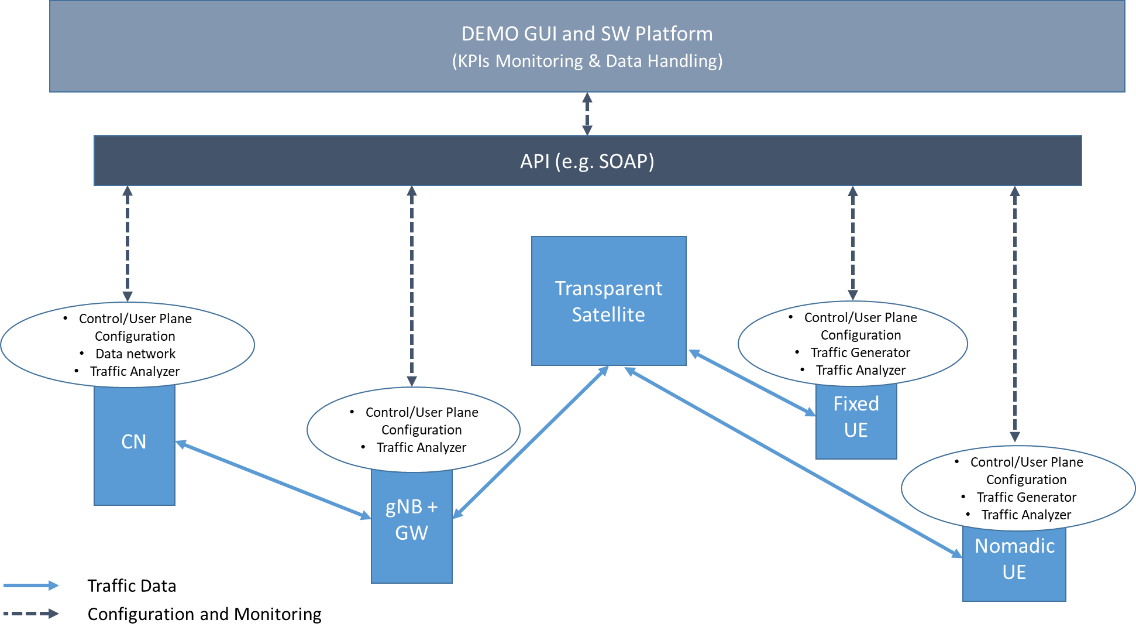
-
StatusOngoing
-
Status date2024-04-26
-
Activity Code7C.057
GADGET Project has the objective to design and implement two User Equipment (UE) and one gNodeB compliant with the 5G release 16 or above to demonstrate the direct access to non-terrestrial-network (NTN) based on a satellite access. These equipment will be integrated in an end-to-end demonstration configuration based on and emulated and live satellite access. This last is represented by the actual access to Athena/Fidus GEO satellite.
In the development of the UEs and the gNodeB, more attention is on the protocol stack implementation in line with the foreseen 5G standard release and starting as base point from an Open-Source software environment. In the implementation of the E2E demonstrator also the simulator of the Core Network will be implemented to perform the foreseen performance and operative tests.
The challenge of the activity is twofold: the development of actual gNB and UE both compliant with the 5G standard and based on New Radio supporting the NTN access actually interfaced with a satellite access node. This last is able to emulate the satellite channel access presenting all the impairments typically experienced by the satellite users.
A 5G satellite system is beneficial for various reasons and different use cases, especially broadband communications in underserved areas, as well as offering an international or even global coverage. The feasibility of a 5G satellite network leads to a reduction of digital divide, and offers broadband connectivity at lower costs than ground infrastructures, especially in underserved or developing areas such as Africa or south-east Asia.
The system includes a 5G-compatible gNB developed in and open approach running on COTS hardware starting from the Release 16, but upgradable in an easy way to be compliant with the latest satellite adaptions, currently in the Release 17 developments.
Also the UEs are developed with the same approach of the gNB. These are easily interfaced with the typical VSAT for the satellite access and can be also utilised for other NTN access interfaces.
The Channel Emulator is providing RF interfaces and Up and Down Conversion from L-Band to Ka-Band and the reverse, allowing to emulate the channel in the bands of interest for the study.
The architecture is defined below.
- Two UEs, one nomadic and one fixed, can establish bidirectional connections with a gNB through a satellite transponder.
- The testbed includes both access and non-access stratum capabilities.
- The testbed allows analysis of E2E performances through predefined sensible KPIs.

The figure shows the system architecture based off the 5G basic blocks. A GUI for monitoring the KPI has been added to the system allowing:
- Configuration of the main functionalities that impact the NTN performances.
- Monitoring and reporting of the KPIs of interest.
- Traffic generation, to emulate the traffic generated by the applications.
The overall network architecture, the protocol stack, the QoS traffic management and the UE/Satellite characteristics are referenced from 3GPP standards, according with the scenario defined in the statement of work.
The Project is organised in two phases:
- Phase 1 – 6 months;
- Phase 2 – 18 months.
The Project Milestones are as follows:
- Phase 1
- Select Platform Baseline – May 2021
- Finalise Technical Specification – June 2021
- Preliminary Design Review (PDR) – September 2021
- Phase 2
- Critical Design Review (CDR) – April 2022
- Qualification Review – January 2023
- Final Review – March 2023
The project kick-off has been in March 2021.
The study is currently underway: the HW and SW have been defined and suitable issues have been identified and addressed starting the design phase activity for the delivery of the first deliverables.




